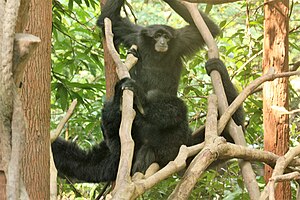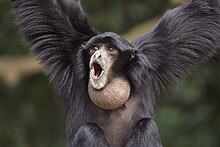Siamang
| Siamang | ||||||||||||
|---|---|---|---|---|---|---|---|---|---|---|---|---|

Siamang group in the zoo |
||||||||||||
| Systematics | ||||||||||||
|
||||||||||||
| Scientific name of the genus | ||||||||||||
| Symphalangus | ||||||||||||
| Gloger , 1841 | ||||||||||||
| Scientific name of the species | ||||||||||||
| Symphalangus syndactylus | ||||||||||||
| ( Raffles , 1821) |
The Siamang ( Symphalangus syndactylus ) is a species of primate from the gibbon family (Hylobatidae). He is the largest and heaviest member of his family.
features
Siamangs have a head body length of up to 90 cm and a weight of up to 12 kg (males) or 11 kg (females). The arms can reach a span of 1.5 m. The face has a flat and broad nose with medium-sized side nostrils, deeply set eyes, and a low forehead.
Regardless of age and gender, all Siamangs have a deep black fur. Some animals get cream-colored hair on their chin or white eyebrows. But these are exceptions that only occur in a few animals, mostly females.
The large, inflatable throat pouch is characteristic of the Siamangs. Another characteristic is the connective tissue connection between the second and third toes, to which they owe their scientific name (the epithet of the species "syndactylus"). Males are identified by a genital tuft.
Distribution area and habitat
Siamangs live in the south of the Malay Peninsula (from the extreme south of Thailand to the south) and on Sumatra . This makes them the only species of gibbon whose range completely overlaps with that of other species (the black-handed and white-handed gibbon ). Also sympatric with the Siamang lives of Sumatran orangutan ( Pongo abelii ).
Forests are the habitat of the Siamangs, both in the plains and in the mountains. You can cope with primary and secondary forests, and even selectively cleared forests. In areas where they are sympathetic to other gibbon species, they prefer higher forests up to 2300 m above sea level.
Way of life and reproduction
Siamangs become active at dawn and go back to sleep later in the afternoon. The daily activity time is over 10 hours. The sleeping places are mostly in the center of their districts. The chants of the Siamangs are made up of complex duets of the male and the female and should also fulfill a couple-binding function. In order to avoid confusion with the sympatric gibbon species, the chants of the Siamangs sound later in the morning than those of the white-handed gibbons, for example. Siamangs also communicate through gestures and facial expressions.
The Siamangs spend 35–50% of the day eating food, 25–44% resting and 12–22% hiking through their territory. Singing, playing or grooming are less common. In the morning the Siamangs move most and take more and longer breaks during the day.
Siamangs have many different locomotion techniques, characteristic is the swinging swing (brachiation), which is used most often (51%), they also climb (37%), walk on their hind legs (6%) or jump (6%).
The only natural enemy is the clouded leopard ( Neofelis diardi ). In order not to be eaten, Siamangs sleep on tall trees and form groups with langurs.
Territories are 15 to 24 hectares in size and often overlap with those of smaller gibbon species. Encounters between the individual groups at the borders are relatively frequent. The males chase each other along the borders and perform chants with the females. Every day they hike up to 3000 m, but mostly only 1000 to 1200 m. The females lead the groups, followed by their young, then the male and the youngsters and adolescents. Groups usually consist of 4 to 9 animals. Although they are actually monogamous, there are also females with two males. The males carry the young and help the females to save energy, which leads to shorter intervals between the births. When they reach sexual maturity, the young usually leave their parents' territory and look for their own territory . Aggressive behavior within a group is often directed against adolescents.
Siamangs eat fruit, but less than other sympatric gibbon species. 42% of the diet is made up of leaves, 32% comprises figs , 12% other fruits, 9% insects and 4% flowers. Figs are mostly eaten early in the morning and late in the evening, which is believed to be a strategy for balancing energy during the night. Although Siamangs mainly eat leaves, they displace the two smaller species from the common feeding grounds.
In captivity, sexual maturity begins at the earliest at 4 years of age for males and at 5 years of age for females, but usually at 8 to 9 years of age. The mating usually takes place dorso-ventrally, but ventro-ventral copulations have also been observed. Pregnancy lasts 189 to 239 days. The birth rate may depend on the abundance of fruits available, but there is no evidence for this. Before giving birth, females reduce their activity rate. Usually a young is born, twins are rare. At birth, a Siamang weighs around 540 g. Infants start eating solid foods at 3 to 9 months, but are mainly suckled for the first 12 months and are completely independent by 2 years. The interval between births is 3 years. They live to be 25 to 30 years old in the wild and up to five years older in captivity.
Hybrids between gray gibbons ( Hylobates muelleri ) and Siamangs are known. They are called "gibbangs" or "siabons" in the English-speaking world. Two female hybrids were born from a single pair that were both wild-caught. The hybrids had black fur, a connective tissue connection between the second and third toes, but no clearly visible throat pouch.
threat
The Siamang is classified by the IUCN as endangered ("critically endangered"). It is protected in Thailand, Malaysia and Indonesia and is found in at least ten protected areas. Its habitat is legally and illegally cleared and then used for agriculture. The populations are getting smaller and smaller, which is due to the increasing lack of suitable habitats. Between 1995 and 2000, 40% of the animal habitat on Sumatra disappeared. Large fires that followed the clearing and drying up the forest floor are responsible for a large juvenile mortality rate that is now higher than the birth rate. Siamangs are hunted or caught. They then serve as pets or are used for traditional Asian medicine. Siamangs are the most common type of gibbon in the pet market in Indonesia, especially in Sumatra, Java, and Bali. There is no information on how many Siamangs actually live in the wild; In the Bukit Barasan Selatan National Park there are 4876 to 6606 groups or an estimated 22,390 individuals.
Systematics
The Siamang is the only species in the genus Symphalangus . The Kloss gibbon , sometimes referred to as "dwarf siamang", is not a close relative of the Siamang despite its black fur, but is classified in the genus of the small gibbons ( Hylobates ).
A distinction is made between the subspecies of the Malay Peninsula ( S. s. Continentis ) and that of the island of Sumatra ( S. s. Syndactylus ). The animals of the mainland are slightly smaller and have a slightly more delicate skull than the subspecies on Sumatra.
literature
- Thomas Geissmann: Comparative Primatology . Springer, Berlin 2003, ISBN 3-540-43645-6 .
- DE Wilson, DM Reeder: Mammal Species of the World . Johns Hopkins University Press, 2005, ISBN 0-8018-8221-4 .
- Russell A. Mittermeier, Anthony B. Rylands, Don E. Wilson: Handbook of the Mammals of the World. Volume 3: Primates. Lynx Edition, Barcelona 2013, ISBN 978-84-96553-89-7 , p. 791.
Web links
- Information from the Gibbon Conservation Center
- Information from the Gibbons Research Lab. (English)
- Symphalangus syndactylus in the endangered Red List species the IUCN 2006. Posted by: A. Eudey & Members of the Primate Specialist Group, 2000. Retrieved on 1 August, 2007.
Individual evidence
- ↑ Jürg Lamprecht: Duettgesang bei Siamang, Symphalangus syndactylus (Hominoidea, Hylobatinae). In: Zeitschrift für Tierpsychologie 27, No. 2, 1970, pp. 186-204, doi: 10.1111 / j.1439-0310.1970.tb01872.x .
- ↑ Katja Liebal, Simone Pika, Michael Tomasello: Social communication in siamangs (Symphalangus syndactylus): use of gestures and facial expressions. In: Primates 45, No. 1, 2004, pp. 41-57.
- ↑ John G. Fleagle : Dynamics of a brachiating siamang [Hylobates (Symphalangus) syndactylus]. In: Nature . Volume 248, 1974, pp. 259-260, doi: 10.1038 / 248259a0 .
- ^ David J. Chivers: The feeding behavior of siamang (Symphalangus syndactylus). In: Primate Ecology 1977, pp. 355-382.
- ^ Richard H. Myers, David A. Shafer: Hybrid ape offspring of a mating of gibbon and siamang. In: Science 205, No. 4403, 1979, pp. 308-310, doi: 10.1126 / science.451603 .
- ↑ Timothy G. O'Brien, Margaret F. Kinnaird, Anton Nurcahyo, Maya Prasetyaningrum, Muhammad Iqbal: Fire, demography and the persistence of siamang (Symphalangus syndactylus: Hylobatidae) in a Sumatran rainforest. In: Animal Conservation 6, No. 2, 2003, pp. 115-121, doi: 10.1017 / S1367943003003159 .
- ^ Russell A. Mittermeier, Anthony B. Rylands, Don E. Wilson: Handbook of the Mammals of the World. Volume 3: Primates. Lynx Edition, Barcelona 2013, ISBN 978-84-96553-89-7 , p. 791.



